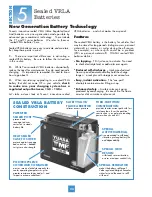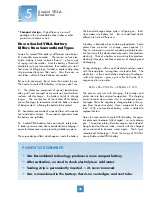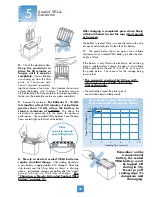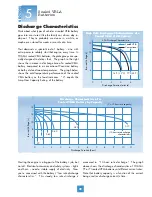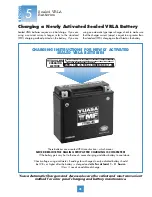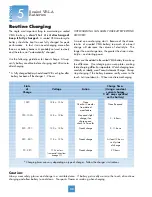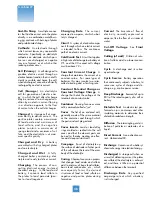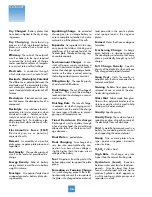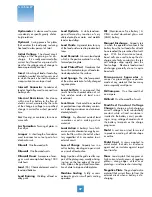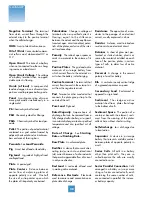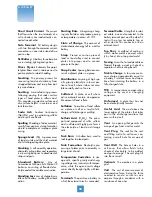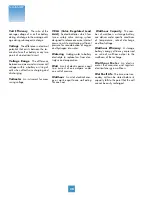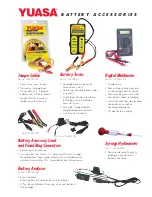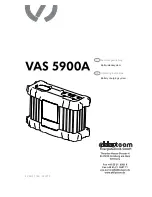
Negative Terminal
The terminal
from which current flows through the
external circuit to the positive terminal
when the cell discharges.
OHM
A unit of electrical resistance.
Oil of Vitriol
Concentrated commer-
cial sulfuric acid, abbreviated OV or
O.V.
Open Circuit
The state of a battery
when not connected to either a charg-
ing source or a load circuit.
Open Circuit Voltage
The voltage
at a battery terminal when no appre-
ciable current is flowing.
Oxide (of lead)
A compound of
lead and oxygen in one of several pro-
portions used to prepare battery paste.
Panel
A casting consisting of two or
more grids made simultaneously in a
single mold.
Pb
Chemical symbol for lead.
PbO
Chemical symbol for litharge.
PbO
2
Chemical symbol for lead per-
oxide.
Pellet
The portion of pasted material
contained in a grid section framed by
adjacent horizontal and vertical mem-
bers exclusive of forming bars.
Peroxide
See
Lead Peroxide
.
Pig
A cast bar of lead or lead alloy.
Pig Lead
A grade of highly refined,
unalloyed lead.
Plate
A pasted grid.
Plate Centers
Distance between
center lines of adjoining plates of
opposite polarity in a cell. One half
the size of a strap center upon which
the plates of like polarity are burned.
Polarization
Change in voltage at
terminals when a specified current is
flowing; equal to the difference
between the actual and the equilibrium
(constant open circuit condition) poten-
tials of the plates, exclusive of the inter-
nal resistance drop.
Porosity
The ratio of open spaces or
voids in a material to the volume of its
mass.
Positive Plates
The grid and active
materials of a storage battery from
which current flows to the external cir-
cuit when the battery is discharging.
Positive Terminal
The terminal that
current flows toward in the external cir-
cuit from the negative terminal.
Post
Terminal or other conductor that
connects the plate group strap to the
outside of the cell.
Pure Lead
Pig Lead.
Rated Capacity
Ampere hours of
discharge that can be removed from a
fully charged cell or battery, at a specif-
ic constant discharge rate at a specified
temperature and at a specified cut-off
voltage.
Rate of Charge
See
Starting
Rate
and
Finishing Rate.
Raw Plate
An unformed plate.
Rectifier
A device that converts alter-
nating (ac) current into unidirectional
(dc) current because of a characteristic
that permits appreciable flow of current
in only one direction.
Red Lead
A red oxide of lead used
in making active material.
Reference Electrode
Electrode
used to measure acid concentration or
plate state of charge.
Resistance
The opposition of a con-
ductor to the passage of an electrical
current, usually expressed in ohms.
Resistor
A device used to introduce
resistance into an electrical circuit.
Retainer
A sheet of glass mat, per-
forated or slotted rubber, plastic or
some other material installed on each
face of the positive plates in certain
types of cells, to deter loss of active
material.
Reversal
A change in the normal
polarity of a cell or battery.
Rib
A vertical or nearly vertical ridge
of a grooved separator or spacer.
Secondary Lead
Reclaimed as
opposed to virgin lead.
Sediment
The sludge or active
material shed from plates that drops
to the bottom of cells.
Sediment Space
The portion of a
container beneath the element; sedi-
ment from the wearing of the plates
collects here without short-circuiting.
Self-discharge
Loss of charge due
to local action.
Separator
A device in a storage
battery that prevents metallic contact
between plates of opposite polarity in
a cell.
Series Cells
All cells in a battery
other than pilot cells. They are so
called because the cells are usually
connected in series.
Series Parallel Connection
Cells
arranged in a battery so two or more
strings of series connected cells, each
containing the same number of cells,
are connected in parallel; this increas-
es battery capacity.
38
GLOSSARY
Summary of Contents for SmartShot Automatic 12V 1.5 Amp 5 Stage
Page 1: ......

